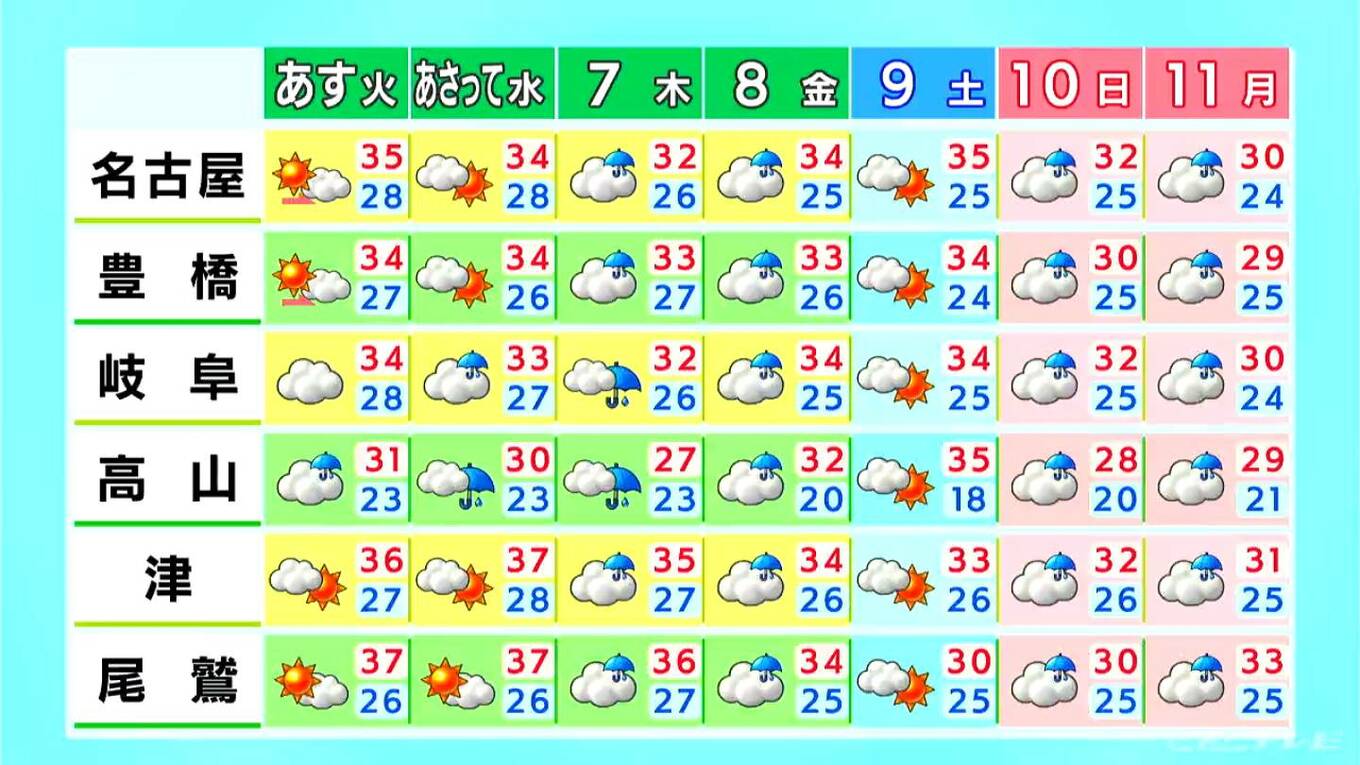Today, intense sunlight will bring scorching heat across the region.
In Nagoya before noon, temperatures exceeded 35°C by 11 AM, creating severe heat conditions.
A heatstroke alert has been issued for Aichi, Gifu, and Mie prefectures. Stay in cool environments using air conditioning, hydrate frequently, and replenish electrolytes to prevent heatstroke.
This afternoon will remain mostly sunny. Due to strong UV rays, consider using parasols or hats for sun protection.
Maximum temperatures are expected to reach 36°C in Nagoya, Gifu, Tsu, and Owase, and 35°C in Takayama. The extreme heat will persist, posing health risks.
[Weekly Forecast]
Gifu Prefecture may experience rain starting Tuesday. Aichi and Mie Prefectures will likely see more rainy days after Thursday. While the extreme heat will ease, high humidity will create muggy conditions. Continue taking precautions against heatstroke.
Nagoya
Nagoya is a major city in Japan’s Chubu region, known for its modern industry, rich history, and cultural landmarks. It is home to Nagoya Castle, built in 1612 by the Tokugawa shogunate, and the Atsuta Shrine, one of Japan’s most important Shinto sites, dating back over 1,900 years. Today, Nagoya is a bustling economic hub, famous for its automotive industry and vibrant food culture, including dishes like miso katsu.
Gifu
Gifu is a historic city in central Japan, known for its rich cultural heritage and natural beauty. It was a significant center during the Sengoku period (15th–16th centuries) and is famous for Gifu Castle, which was originally built in the 13th century and later used by the warlord Oda Nobunaga. The city is also renowned for cormorant fishing (ukai), a traditional method practiced on the Nagara River for over 1,300 years.
Aichi
Aichi is a prefecture in Japan’s Chubu region, known for its rich history, modern industry, and cultural landmarks. It is home to Nagoya, Japan’s fourth-largest city, and historic sites like Nagoya Castle, built in 1612 by the Tokugawa shogunate. Aichi is also famous for its traditional crafts, such as Seto pottery, and as the headquarters of major companies like Toyota.
Mie
Mie Prefecture, located in the Kansai region of Japan, is known for its rich history, stunning natural landscapes, and sacred sites. It is home to the Ise Grand Shrine (Ise Jingu), one of Shinto’s most important shrines, which dates back over 2,000 years and is dedicated to the sun goddess Amaterasu. The region also boasts the scenic Kumano Kodo pilgrimage routes, ancient pearl farming traditions in Toba, and delicious local cuisine like Ise udon and Matsusaka beef.
Tsu
Tsu is the capital city of Mie Prefecture in Japan, historically known as the seat of the Tsu Domain during the Edo period. The city is home to cultural sites like Tsu Castle, built in the 16th century, though only ruins and a reconstructed turret remain today. Tsu also hosts the lively Tsu Summer Festival, featuring traditional dances and fireworks, reflecting its rich local heritage.
Owase
Owase is a coastal city located in Mie Prefecture, Japan, known for its scenic beauty, lush forests, and rich fishing culture. Historically, it flourished as a key port town during the Edo period (1603–1868) for timber and seafood trade, particularly for its high-quality *katsuobushi* (dried bonito). Today, Owase is part of the Kumano region, offering access to traditional shrines, hot springs, and the rugged coastline of the Kumano-nada Sea.
Takayama
Takayama, located in the mountainous Gifu Prefecture of Japan, is a historic city known for its well-preserved Edo-period streets and traditional wooden houses. Often called “Hida-Takayama,” it flourished as a wealthy merchant town due to its high-quality timber and skilled carpentry. Today, it is famous for its biannual Takayama Festival, centuries-old sake breweries, and the nearby UNESCO-listed Shirakawa-go village.
Tokai Prefectures
The Tokai region in Japan consists of four prefectures—Aichi, Gifu, Mie, and Shizuoka—located along the Pacific coast. Historically significant, it was part of the ancient Tokaido road connecting Kyoto and Edo (Tokyo) and is known for its industrial growth, cultural heritage, and natural beauty, including Mount Fuji. The area is also home to landmarks like Nagoya Castle and the Ise Grand Shrine, reflecting its rich historical and spiritual importance.






